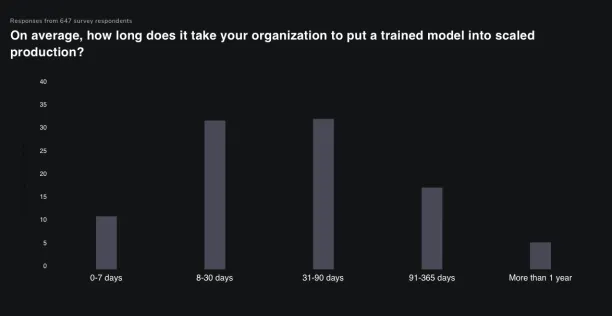Feature Stores in 2024: What is it? & Benefits
According to a survey by Anaconda, data scientists spend nearly half of their time on data preparation.1 According to another study, it can take over a year to take a trained model into production (Figure 1) 2.
Figure 1. How long does it take to put a trained model into production?

Source: Algorithmia
Organizations have started to adopt MLOps practices to overcome the challenges of model development and deployment processes and to streamline the machine learning lifecycle. One of the key components of MLOps is feature stores, which are used by companies like Uber 3, AirBnB 4, and Netflix 5. In this article, we will examine what a feature store is, its benefits, functions, and when it is needed.
What is a feature?
A feature is an independent variable that affects the prediction of an ML model. For example, when predicting the delivery time of shipping, a feature can be the stock status of the product, the current workload of the shipper, the weather conditions, etc. Since raw data is rarely suitable to be used as an input to ML models, these features that are relevant to the problem at hand must be created through feature engineering.
A feature can be offline or online:
- Offline features are variables that do not vary too often. For instance, in case of order shipping, the preparation time of the order is relatively constant if the ordered item is in stock. These types of features can be recalled via the data warehouse.
- Online features are variables that change often and need to be updated in real-time. For instance, the weather condition is an online feature when predicting the delivery time.
For an ML model to function efficiently, both kinds of features should be considered.
What is a feature store?
Cleaning and extracting data through feature engineering, and the creation of data pipelines are complex operational processes. As the number and complexity of ML models increase, the time and computational power required to accomplish these processes also increase.
A feature store enters the picture at this point. It is a platform that
- Stores the created features to be accessed and reused in future problems,
- Enables the management of all features from a centralized place and makes them accessible for different teams,
- Provides the metadata of a feature.
What are the advantages of a feature store?
Feature stores enable businesses and data science teams to:
Save time through advanced feature reusability
Creating features is a time-consuming process that requires domain expertise about the problem. Feature stores help data science teams store the features that are created for a problem and reuse them for another problem. For example, the processed data about the average shipping time of a company or the standard delivery time of a restaurant can be utilized by various models. Reusability of features helps ML teams to accelerate the ML model development process.
Improve collaboration
Different teams can use the same feature for different purposes. Storing features in a centralized platform makes them accessible to different teams developing different ML models. This improves collaboration between ML teams such as data scientists, data engineers, or MLOps engineers.
Make model training and model inference consistent
Feature stores can help eliminate the “online/offline skew” problem. This problem refers to the difference in model performance during model training and inference due to the use of different features in these settings. By improving accessibility and reusability of features, feature stores eliminate this problem and improve the consistency of model performance between training and inference.
When to use a feature store and how to get started?
Feature stores can benefit all ML projects but if you have different teams that develop and manage multiple ML models, a feature store is a must-have tool. Scaling ML and AI projects across your organization requires a systematic approach such as MLOps and feature stores are often a part of MLOps platforms.
Alternatively, you can build your feature store with in-house resources if you have specific needs. However, this can also be a time-consuming process and is often preferred by large companies. 6
Further reading
If you have other questions about feature stores or MLOps, feel free to reach out:
External Links
- 1. “The State of Data Science 2020 Moving from hype toward maturity.” Anaconda. Revisited January 20, 2023.
- 2. “MLops.” DataRobot. Revisited January 20, 2023.
- 3. “Optimal Feature Discovery: Better, Leaner Machine Learning Models Through Information Theory.” Uber. 2021. Revisited January 20, 2023.
- 4. AirBnB
- 5. “Distributed Time Travel for Feature Generation.” Netflix Tech Blog. 2016. Revisited January 20, 2023.
- 6. Features

Cem has been the principal analyst at AIMultiple since 2017. AIMultiple informs hundreds of thousands of businesses (as per similarWeb) including 60% of Fortune 500 every month.
Cem's work has been cited by leading global publications including Business Insider, Forbes, Washington Post, global firms like Deloitte, HPE, NGOs like World Economic Forum and supranational organizations like European Commission. You can see more reputable companies and media that referenced AIMultiple.
Throughout his career, Cem served as a tech consultant, tech buyer and tech entrepreneur. He advised businesses on their enterprise software, automation, cloud, AI / ML and other technology related decisions at McKinsey & Company and Altman Solon for more than a decade. He also published a McKinsey report on digitalization.
He led technology strategy and procurement of a telco while reporting to the CEO. He has also led commercial growth of deep tech company Hypatos that reached a 7 digit annual recurring revenue and a 9 digit valuation from 0 within 2 years. Cem's work in Hypatos was covered by leading technology publications like TechCrunch and Business Insider.
Cem regularly speaks at international technology conferences. He graduated from Bogazici University as a computer engineer and holds an MBA from Columbia Business School.
To stay up-to-date on B2B tech & accelerate your enterprise:
Follow on

Comments
Your email address will not be published. All fields are required.